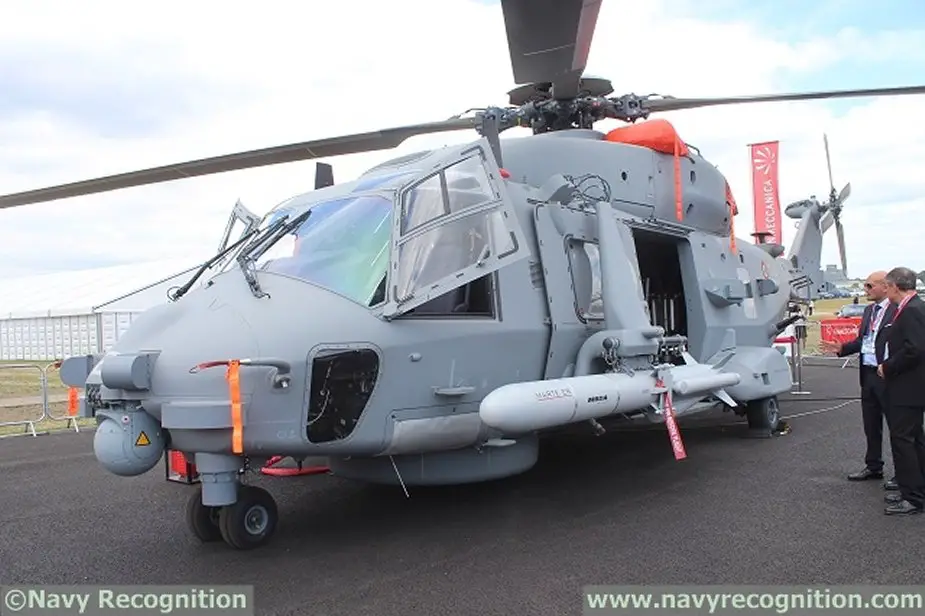Breaking news
Rheinmetall modernizes simulators for the NH90 naval helicopter.
According to a PR published by Rheinmetall on July 20, 2022, the firm has scored another success with Asterion, its range of world-leading simulator products. Group subsidiary Rheinmetall Electronics GmbH has been awarded a follow-up contract by its partner company Reiser Simulation und Training GmbH (RST) for simulators for the NH90 NFH Sea Lion naval helicopter.
Follow Navy Recognition on Google News at this link
 NH90 Naval helicopter at Farnborough International Airshow 2014. (Picture source: Navy Recognition)
NH90 Naval helicopter at Farnborough International Airshow 2014. (Picture source: Navy Recognition)
Rheinmetall’s Bremen-based simulation specialists have been tasked with upgrading the “Functional Cockpit” Asterion cockpit trainer. The Functional Cockpit is part of the maintenance training rig for the NH90 developed and supplied by Reiser Simulation und Training GmbH for the German Navy Air Station in Nordholz.
These simulators enable maintenance personnel of the Bundeswehr’s Naval Air Squadron 5 to carry out realistic maintenance and repair operations. The simulators will be completely modernized by 2024.
This upgrade will make it possible for Navy personnel to train for the latest configuration of the NH90 NFH Sea Lion naval helicopter. It thus marks an important milestone for use of the maintenance training rig in combination with the integrated “Functional Cockpit” Asterion cockpit trainer for the
German Navy’s NH90 NFH.
Rheinmetall’s outstanding Asterion product range is a dynamic, highly realistic training asset for instructing technical personnel. Asterion’s lifelike simulation of the original equipment is compelling. Rheinmetall thus makes it possible to provide totally realistic training for NH90 ground personnel for German Army and Navy aviation units alike.
Final acceptance testing of the world’s first Asterion cockpit trainer for the Army version of NH90 TTH took place back in December 2016. This simulator was then transferred to the international helicopter training center at Faßberg in Lower Saxony.
Then, in August 2017, Rheinmetall received an order to further develop its highly sophisticated Asterion training simulation software and to integrate it into Reiser Simulation und Training GmbH’s maintenance training rig, or MTR.
The MTR replicates all relevant functions for the first expansion phase of the German Navy’s new NH90 NFH Sea Lion multipurpose helicopter in Nordholz.
Aided by data collected from the German Navy’s real helicopters, Rheinmetall will now adapt the software to the current configuration of the NH90 helicopter and integrate it into the Functional Cockpit.
This will ensure that the behavior of the training asset is identical to that of the original equipment, a vital prerequisite for effective instruction and training of German Navy maintenance and repair personnel.
The latest order is another important milestone for Rheinmetall in the field of maintenance training resources, supporting high-quality training for users in line with European Military Airworthiness Requirements (EMAR).
About the Naval helicopter NH90
The NHIndustries NH90 is a medium-sized, twin-engine, multi-role military helicopter. It was developed in response to NATO requirements for a battlefield helicopter that would also be capable of being operated in naval environments.
The flight envelope of the NH90 is capable of all-weather day-and-night operations, ship-borne operations during high sea states, across a temperature range from −40 °C to +50 °C, and up to a maximum altitude of 20,000 feet.
Power is provided by a pair of turboshaft engines, dependent on customer selection, the NH90 is either fitted with Rolls-Royce Turbomeca RTM322 or General Electric CT7-8F powerplants; exhaust gases from the engines are filtered through an infrared suppression system for decreased sensory visibility.
The NH90 features an advanced composite airframe, designed for ballistic tolerance, a high level of crashworthiness, lower weight, and 30 per cent greater endurance than a metallic counterpart.
The four main rotor blades are also composed of composite materials, increasing fatigue strength and lifespan while providing for greater damage tolerance.


























